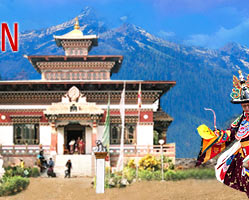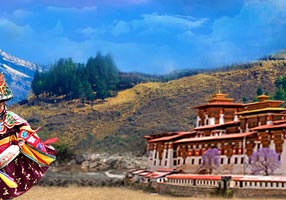Sprawling across 4,349 sq km, Jigme Dorji National Park is Bhutan's largest sanctuary. Named after the third King of Bhutan, who is often referred to as the Father of Modern Bhutan, diverse species of flora and fauna flourish in this wildlife sanctuary. This national park covers the entire district of Gasa and the western areas of Thimphu and Paro districts. Goral, the primitive and rare mountain goat, is unique to it though. Gorals are solitary in nature and are monomorphic (males and females look alike). On the southern boundary of Jigme Dorji National Park, Cheri Monastery is situated at an altitude of 2600 m above sea level on a steep mountain slope. It has the distinction of being the seat of the first monastic body in Bhutan. Shabdrung Ngawang Namgyal, a Tibetan holy man, built it in 1620.
On one side of the monastery, there are broad-leaved forests boasting of oak, rhododendron, maple and walnut trees and on the other side, there are conifer forests having spruce trees, fir, hemlock and the Himalayan yew. The River Thimphu Chhu that originates in the Jigme Dorji National Park is quite furious in summer, when it fed by the melting snow, and its white torrential waters form emerald-green pools throughout the park. The blood-red flowers of rhodendron and other blooming flowers around the monastery present a colorful and picturesque view in the Spring season. The thrilling drive to the base of the mountain and the uphill walk along a well-maintained path is a treat for all the bird lovers.
You can spot several bird species here such as rare black-necked cranes, white-capped water redstarts, blue whistling thrushes, white-throated laughing thrushes, yellow-billed blue magpies, Himalayan monal and the spotted nutcracker. Cheri goral can easily climb the rock-face, which provides them the escape point from predators such as tigers, leopards and dogs. The altitudes vary widely throughout the park, from 1400 m to 7000 m, covering eight of the eleven vegetation zones found in Bhutan. Jigme Dorji National Park has more than 30 species of mammals, 300 species of birds, and 1400 species of plants. Black bears, markot, sambar, barking deer, takin and musk deer are also found in this preserved area. Semi-nomadic people living here are mostly yak herders; harvests medicinal and aromatic plants and subsist on marginal agriculture and forest products.
It is the country’s most active geothermic region and Himalayan herbs found here are used in traditional Bhutanese medicines. Trekkers love this place and the hot springs of the park, known as Gasa Tsachhu, are famous for their therapeutic effects. One of the most biologically rich areas in the Eastern Himalayan region, Jigme Dorji National Park boasts of warm broad-leaved forests, permanent ice fields and even glaciers. Sacred peaks such as Jomolhari, Tsherimgang and Jichu Drakey are some of the most significant landmarks in the park and its glaciers and glacial lakes are source of some of the Bhutan’s main rivers. In the alpine region, you can see the rare blue poppy, edelweiss, orchids and rhododendrons and it is perhaps the only place in the world where you can find snow leopards and the Royal Bengal tiger existing together.




